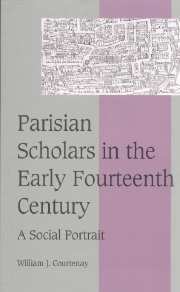Book contents
- Frontmatter
- Contents
- List of maps and figures
- Preface
- List of abbreviations
- INTRODUCTION: PARIS IN 1329
- Part I The recovery and context of a document
- Part II A window on a lost world
- 4 ACADEMIC SPACE: THE TOPOGRAPHY OF THE UNIVERSITY COMMUNITY
- 5 LODGING AND RESIDENTIAL PATTERNS
- 6 THE SOCIOLOGY OF THE UNIVERSITY COMMUNITY
- 7 THE GEOGRAPHICAL ORIGINS OF THE UNIVERSITY COMMUNITY
- CONCLUSION
- Part III Biographical register
- Select bibliography
- Index of persons and places
- Subject index
- Cambridge Studies in Medieval Life and Thought Fourth series
6 - THE SOCIOLOGY OF THE UNIVERSITY COMMUNITY
Published online by Cambridge University Press: 17 August 2009
- Frontmatter
- Contents
- List of maps and figures
- Preface
- List of abbreviations
- INTRODUCTION: PARIS IN 1329
- Part I The recovery and context of a document
- Part II A window on a lost world
- 4 ACADEMIC SPACE: THE TOPOGRAPHY OF THE UNIVERSITY COMMUNITY
- 5 LODGING AND RESIDENTIAL PATTERNS
- 6 THE SOCIOLOGY OF THE UNIVERSITY COMMUNITY
- 7 THE GEOGRAPHICAL ORIGINS OF THE UNIVERSITY COMMUNITY
- CONCLUSION
- Part III Biographical register
- Select bibliography
- Index of persons and places
- Subject index
- Cambridge Studies in Medieval Life and Thought Fourth series
Summary
Earlier generations of historians often described medieval universities as avenues of social opportunity where the sons of townspeople and those from rural villages could receive a higher education and, with it, the possibility of upward mobility through church and court. The case of Robert of Sorbon provides a successful example, a person of rural and humble background who rose through the university and royal service to a position of wealth and power. Presumably, those from the middle level of medieval society took advantage of universities, which the truly poor could not afford without a patron, and which those of wealth and nobility did not need.
In recent decades, however, as more prosopographical work has been done on medieval universities, the appearance within university communities of sons of noble and powerful families has been increasingly observed. The “aristocratization” of medieval universities, as this phenomenon is sometimes labeled, is thought to have been a element that entered university life in the late fourteenth century and did not become a major factor until the fifteenth century. The computus of 1329–30 provides a chance to test the extent to which wealth and social power were already factors in university life, at least at Paris, in the early fourteenth century.
RICH AND POOR
To address that issue, we must first determine how representative a cross section of the university is contained in the computus. As discussed in Chapter One, the computus numerically accounts for about two-thirds of the secular university community at Paris in 1329–30.
- Type
- Chapter
- Information
- Parisian Scholars in the Early Fourteenth CenturyA Social Portrait, pp. 92 - 106Publisher: Cambridge University PressPrint publication year: 1999



